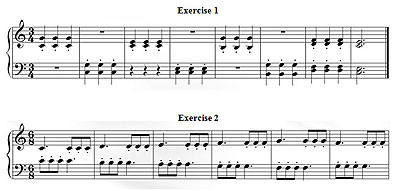 Staccato dots are placed either below the note heads when the tails are up or above note heads when tails are down.
Staccato dots are placed either below the note heads when the tails are up or above note heads when tails are down.
To play staccato notes, touch the keys in a short and detached manner with firm finger tips but with a loose wrist and arm.
Imagine that the keys themselves are hot and you must bounce off the note to achieve the desired effect.
There are different kinds of staccato – finger, wrist and forearm staccato.
Finger Staccato – let the knuckle originate the movement, tapping the finger down in a brisk, short movement before returning to its original place
Wrist Staccato – keep the fingers relatively still and allow the weight of the wrist to create the short sound required.
You will notice that the wrist staccato produces a stronger sound than the finger staccato.
Forearm Staccato – Use the force and weight of the forearm (from the elbow down) to create the sound.
This form of staccato is usually reserved for pieces that require a very strong sound.

Want to learn more …
 No music theory, background or knowledge required. Anyone can learn how play piano with our easy system.
No music theory, background or knowledge required. Anyone can learn how play piano with our easy system.
It doesn’t matter what age you are or which country you live in. The course will show you how to play piano from beginning to end.
With our standard step-by-step instructions & video, ‘Beginners Guide To Piano’ is what you need to stop struggling, feeling overwhelmed and frustrated with your current lessons.
We give you our qualified piano teacher plus the need to know topics to help you learn quicker and with minimal stress doing so.
